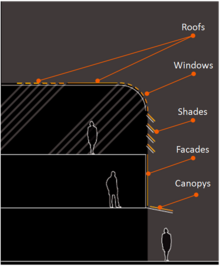Building-integrated photovoltaics

Building-integrated photovoltaics ( GiPV ), often also called BiPV (from English Building-integrated Photovoltaic ), stands for the integration of photovoltaic modules into the building envelope, whereby not only traditional energy generation (conversion of sunlight into electrical energy), but also other functions are desired . The specialist group “Photovoltaics in Buildings” under the umbrella of the Bundesverband für Bausysteme e. V. describes BiPV as an architectural, structural and structural integration of PV elements into the building envelope, taking into account the multifunctional properties of the PV module. Multifunctionality can be weather protection , thermal insulation , shading, aesthetics and design as well as privacy protection, sound insulation, electromagnetic shielding attenuation , burglary protection, light control and light guidance.
Application area
BiPV is used in the area of roof integration, facade, window and shading solutions. Project-oriented variants (adapted to the respective building) in size, shape, material, color, variance in transparency and design are desired in order to achieve an overall appearance that is as homogeneous as possible.
Used modules
In order to meet the architectural requirements and the desired multifunctionality, adaptability of the PV modules in terms of size, shape and materials used is desired. The various mechanical and electrical integration requirements must also be taken into account.
There are basically two variants of technologies that can be used for modules for BiPV:
Crystalline modules
Crystalline modules are based on a plurality of silicon - wafers constructed, usually in the serial connection. The grid dimension of the variation in size is determined by the size of the wafer and the necessary free space for interconnection and isolation. These amount to 15-25 cm. When it comes to cell material, a distinction is made between monocrystalline and polycrystalline silicon, which differ in their efficiency. This indicates what percentage of the incoming solar energy is converted into electrical energy. (Mono-) crystalline modules today offer the highest degree of efficiency (15–20%) with optimal alignment. In the BiPV, however, such an optimal alignment (e.g. facade with vertical alignment) is usually not given. Furthermore, crystalline solutions are very susceptible to shading and a reduction in performance at high temperatures, which are common in building applications. It is therefore advisable to use simulation software for the true energy yield. Crystalline solutions have a high variability in the choice of packaging material, which is very positive for BiPV. Different glass thicknesses, but also plastics, can be used, but crystalline cells are very prone to breakage and cannot be bent. Semi-transparency in simple patterns can also be created.
Thin-film modules
Thin-film modules are applied to a substrate (mostly glass). With the glass substrate variant, a size variance is only possible to a very limited extent. The choice of materials for this variant of the substrate is also very limited, since very high temperatures are used during the process of PV cell construction, which do not allow certain variations in the glass (e.g. safety glass).
Other thin-film solutions are z. B. applied to plastic or metal strips ( steel , copper ). These solutions currently offer the highest degree of variation in size and packaging and also allow flexible and very light solutions (plastic / plastic) to be offered. Thin-film solutions currently have efficiencies of 6-14% depending on the technology used, have a better yield with suboptimal alignment (scattered light, weak light) and are less temperature-dependent in their performance.
Special grants
Various political measures promote the use of BiPV: Driven by the 20-20-20 targets and the desire to promote energy-self-sufficient buildings, in some countries (e.g. Italy , France ), in addition to the feed-in tariffs (see Germany EEG ) offered increased tariffs for BiPV.
Building guidelines
A strong driver for the use of BiPV is the successive tightening of guidelines regarding the energetic behavior of buildings ( zero energy house , CO 2 footprint ). In Germany, the EnEV is the reference here, which is based on the EU directive on the overall energy efficiency of buildings. Furthermore, there are country-specific sustainability- related building assessments with different quality levels, which also promote high energy building quality and low environmental impact . Examples of this are the Leadership in Energy and Environmental Design (LEED) developed in the USA , BREEAM from Great Britain and the German Sustainable Building Certificate .
literature
- Ingo Bert Hagemann: Building-integrated photovoltaics: Architectural integration of photovoltaics into the building envelope. Müller, Cologne 2002, ISBN 3-481-01776-6 (also dissertation at RWTH Aachen 2002).
- Simon Roberts, Nicolò Guariento: Gebäudeintegrierte Photovoltaik, Ein Handbuch (Original title: Building Integrated Photovoltaics , translated by Büro Antoinette Aichele-Platen), Birkhäuser, Basel 2009/2013, ISBN 978-3-7643-9949-8 .
- Thomas Seltmann: Photovoltaics: solar power from the roof . 4th, updated edition, Stiftung Warentest , Berlin 2013, ISBN 978-3-86851-082-9 .
- Thorsten Schütze: Photovoltaics in Architecture. In: Deutsche Bauzeitschrift No. 4/2014, pp. 68–72
Web links
- Specialist group for building-integrated photovoltaics of the Federal Association of Building Systems
- Building-integrated photovoltaics: A new market opens up perspectives and potential . Report, solarserver.de, undated (overview of technologies, application systems and market)
Individual evidence
- ↑ Building-integrated photovoltaic systems - position paper of the specialist group "Building-integrated photovoltaics" ( Memento of the original from January 24, 2016 in the Internet Archive ) Info: The archive link was automatically inserted and not yet checked. Please check the original and archive link according to the instructions and then remove this notice.
- ↑ 20-20-20 goals
- ↑ Directive 2010/31 / EU of the European Parliament and of the Council of May 19, 2010 on the overall energy efficiency of buildings (PDF)
